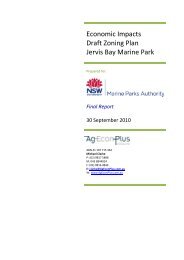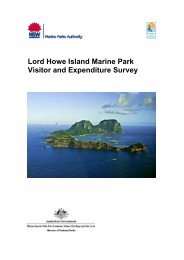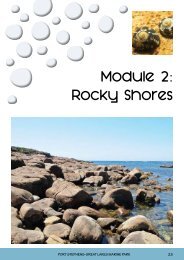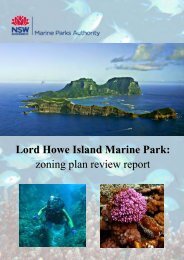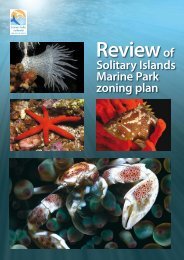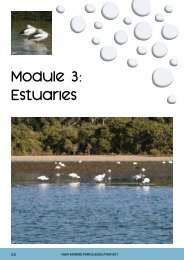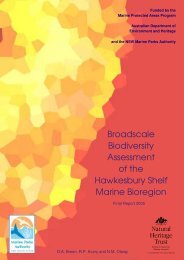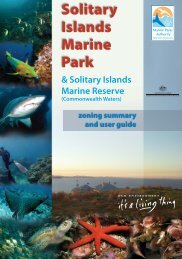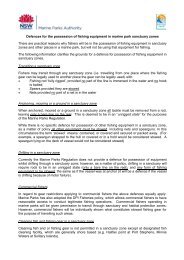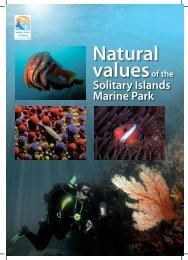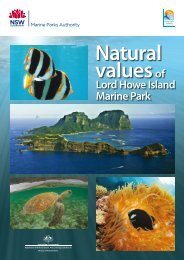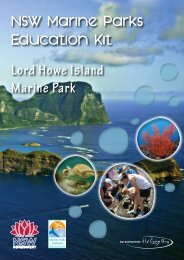Research Project Summaries 2002-2009 - Marine Parks Authority ...
Research Project Summaries 2002-2009 - Marine Parks Authority ...
Research Project Summaries 2002-2009 - Marine Parks Authority ...
Create successful ePaper yourself
Turn your PDF publications into a flip-book with our unique Google optimized e-Paper software.
y the MPA on reefs throughout the marine park only found corallimorphs on reefsattached to islands.There is also evidence of interactions between corals and aggregations of a tubebuildingpolychaete worm Chaetopterus longipes in the marine park (Smith <strong>2002</strong>).Initial studies indicated that branching colonies were most often affected by wormaggregations and a manipulative transplant experiment was conducted to determinethe effect of interactions on growth rate and survival of Pocillopora damicornis,Acropora solitaryensis and A. valida, the three most common branching corals at thestudy site. The results indicate that tube worms may be an important source ofmortality for corals in the marine park. As recent anecdotal evidence suggests thatChaetopterus aggregations are increasing at some sites, larger scale monitoring ofinteractions and outcomes is recommended to determine the threat to marginal coralcommunities.Although there is considerable potential for impacts, overall coral cover has beenmaintained between <strong>2002</strong> and 2006 at monitored sites. Surveys were conducted at 16mid-shelf sites in the marine park using six 25 m video belt transects per site in <strong>2002</strong>,2004 and 2006.<strong>Marine</strong> pestsA risk assessment of introduced marine pests from the Camden Haven River to TweedHeads was carried out for the Northern Rivers Catchment Management <strong>Authority</strong>(Catterall et al 2007). This examined the likelihood of invasion by pest species in themarine park, to assist with management of pests.<strong>Marine</strong> pest species considered to have the highest potential for invasion, in order ofimportance, were the Asian green mussel Perna viridis, broccoli weed Codium fragilessp. tomentosoides, black-striped mussel Mytilopsis sallei, aquarium Caulerpa Caulerpataxifolia, giant fanworm Sabella spallanzanii, Asian mussel Musculista senhousia,Pacific oyster Crassostrea gigas and European shore crab Carcinus maenas.4.2 Jervis Bay <strong>Marine</strong> Park4.2.1 Development and infrastructureMonitoring of mangrove and saltmarsh in Jervis Bay <strong>Marine</strong> ParkCurrambene, Callala and Moona Moona creeks on the eastern shore of Jervis Bayhave been subject to impacts including grazing, catchment modification for housing,and dredging. A range of studies has been conducted to determine the effects of theseimpacts (Saintilan and Williams 1999, Saintilan and Wilton 2001, Rogers and Saintilan2006, Rogers et al 2006), addressing three main areas:studies of the changing distribution of mangrove and saltmarsh in Jervis Baycreeks, over the last 50 years and over thousands of years in the case ofCurrambene Creek, using the palaeo-stratigraphy of mangrove and saltmarshstudies of the surface elevation and contemporary sedimentation trends inCurrambene Creek (and Cararma Inlet) using surface elevation tables andfeldspar marker horizonsmonitoring of the condition of saltmarsh in Moona Moona Creek compared withother creeks in Jervis Bay, using fixed vegetation plots.Mangroves and saltmarshes are found in all four main creeks of Jervis Bay:Currambene Creek, Moona Moona Creek, Callala Creek, and Cararma Inlet – which isSolitary Island and Jervis Bay <strong>Marine</strong> <strong>Parks</strong> <strong>Research</strong> <strong>Project</strong>s <strong>Summaries</strong> <strong>2002</strong>–<strong>2009</strong> 33



